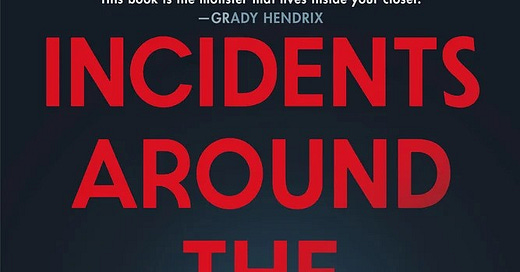Incidents Around the House: Figuring out how to write about horror fiction
I'm hoping to read more horror novels in the coming year, so this is a good way to get started.
Incidents Around the House
By Josh Malerman
Published by Del Rey Books, 2024
Buy it
Figuring out how to write about horror stories isn’t always easy. Providing too much detail about what happens in a story can make it less effective for those who might want to experience it, so it becomes necessary to be kind of vague, discussing the plot or other elements in a roundabout manner. But some sort of analysis is necessary to keep a review from being just a basic description and a brief thumbs-up or thumbs-down recommendation. So please pardon me as I figure out exactly what to talk about when talking about this book.
Josh Malerman has been writing horror fiction for the past 10 years or so, with his debut novel, Bird Box, probably being the most famous due to its adaptation into a widely-seen movie on Netflix. I never did see that film, mostly because it’s reputed to be kind of dumb, despite its popularity. But it does seem like Malerman has been consistently publishing novels and short stories, and his latest, Incidents Around the House, has made a bit of a splash in the horror community.
The reasons for this book’s acclaim seem somewhat evident, since it has a unique structure and a memorable point of view. It’s told from the perspective of a young girl named Bela (her age is never specified, but it seems to be somewhere between 7 and 10, if I had to guess) who is dealing with some sort of supernatural creature that has been haunting her. She calls it “Other Mommy,” and while it started off seeming like an imaginary friend that provided some companionship, it has become more and more sinister, appearing most of the time when she’s alone in her room and constantly asking if she will let it come into her heart.
That’s a fairly creepy concept, and Malerman does his best to put us in the mind of a child who doesn’t really understand what is happening and is starting to become frightened of what Other Mommy might do. Bela’s narration lets us know that she’s worried about whether she should accept Other Mommy’s offer just to keep it from messing with her parents or making the same offer to them. As Other Mommy gets more and more emphatic in its attempts to get what it wants, Bela starts to struggle with whether she should let her parents know what is going on.
At the same time, the book looks at Bela’s struggles to understand what is happening in her parents’ lives. While their home life generally seems happy, with her father working from home and taking care of Bela most of the time and the couple regularly having friends over for parties, it becomes clear that Bela’s mom is having an affair, and the revelation of a sinister, threatening force in their lives could upset things too much. Malerman mostly conveys these details organically, although he does regularly rely on the conceit of having Bela’s parents deliver long monologues to her about their worries and concerns when they think she’s sleeping. But he also plays with this idea a bit by having Other Mommy impersonate them in order to try to get what it wants, which definitely provides some creepy moments.
One notable element about the book is the avoidance of the usual trope of nobody believing the person being haunted when they try to tell others about what is happening. While Bela’s parents do seem to write off her comments about Other Mommy as a child’s imagination at first, when it becomes clear that something weird is happening, they take the threat seriously and try to figure out what to do about it. That’s pretty refreshing, and it makes for a fairly unique change from the typical haunted house story, especially when the family tries to seek refuge in other locations and continues to experience freaky stuff, feeling like there is nothing they can do to escape this threat.
Without giving away too many details, the focus of the story eventually turns into a rumination on how children interact with the adult world and try to understand things that they don’t have the maturity or experience to grasp. In stories like this, I tend to look for metaphors, and I initially thought it was about the ways adults or other abusers manipulate children by taking advantage of their lack of knowledge and convincing them that they should trust them. Other Mommy’s constant requests to Bela are especially horrific because of their manipulative nature, saying that she should acquiesce because that’s what friends do or stating that her refusal will lead to consequences. That’s the language that abusers use, and it can be pretty upsetting in any context.
However, Malerman eventually turns the subtext about childhood innocence into text, which I found to be a bit less effective. The climax of the book features some big emotional revelations, causing Bela to experience a great deal of turmoil and leading to a finale that was probably supposed to seem inevitable but ended up being more like one last shock to end things on. In the end, the message seemed kind of muddled, calling the purpose of the whole thing into question.
However, that may be my failing, as I try to figure out how everything could be wrapped up in a neat package that includes a clear message. Real life isn’t that neat and tidy, and Malerman may be trying to emphasize the messiness of human relationships and the mistakes we make as we try to figure out the best solutions for impossible problems. Sometimes, even when people try their best, they still fail. That’s one way horror can seem especially horrific.




